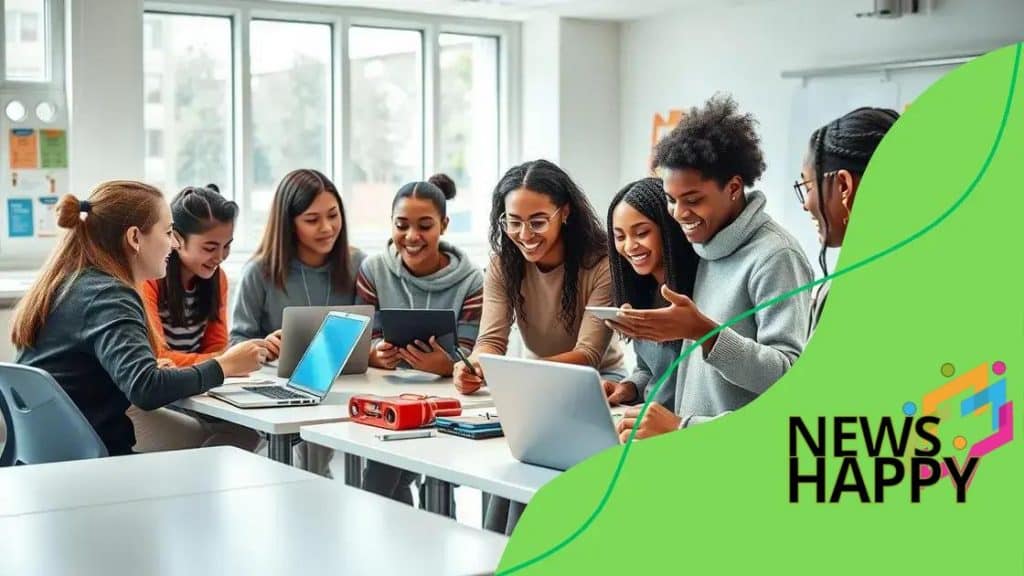The rise of collaborative learning platforms in schools

Anúncios
The rise of collaborative learning platforms in schools enhances teamwork and engagement through real-time communication and shared resources, preparing students for future challenges.
The rise of collaborative learning platforms in schools is changing how we approach education today. Have you noticed how technology is reshaping the classroom experience? Let’s delve into this exciting development.
Anúncios
What are collaborative learning platforms?
Collaborative learning platforms are changing the way students interact with each other and their teachers. These tools allow students to work together on projects, exchange ideas, and build skills in a supportive environment.
Definition of Collaborative Learning Platforms
At their core, collaborative learning platforms are digital spaces where learners can share resources, communicate, and engage in group activities. They promote teamwork and enhance understanding through collaboration.
Key Features of Collaborative Learning Platforms
Many of these platforms include essential features that facilitate interaction.
Anúncios
- Real-time communication: Students can chat or video call to discuss ideas.
- Shared resources: Users can upload documents, images, and videos for group access.
- Task management: Tools that help organize assignments and track progress.
- Interactive tools: Features like quizzes and discussion boards enhance participation.
With these tools, learning becomes a group effort. Imagine classmates discussing a project from their homes, sharing thoughts, and editing documents in real time. This dynamic fosters creativity and deepens understanding.
Moreover, they break down the barriers of traditional classroom settings. Students can collaborate across geography, making global learning opportunities possible. This not only enriches their educational experience but also prepares them for the modern workforce.
By utilizing collaborative learning platforms, educators can create a more inclusive and engaging environment. This encourages student autonomy and responsibility, as learners take charge of their education together. In this interconnected world, learning from peers is invaluable.
Benefits of collaborative learning for students
Collaborative learning offers numerous advantages for students, making it an essential part of modern education. By working together, students can enhance their skills and understanding in meaningful ways.
Enhanced Communication Skills
One of the significant benefits of collaborative learning is improved communication. Students learn how to express their ideas clearly and listen to others. This fosters a spirit of teamwork and encourages open discussions.
Greater Engagement and Motivation
When students collaborate, they tend to be more engaged. Sharing responsibility for group tasks keeps students motivated. They know their contributions matter, which boosts their confidence and desire to learn.
Development of Critical Thinking
Working with peers challenges students to think critically. They must evaluate different viewpoints and make decisions together. This collaborative process helps them develop problem-solving skills that are crucial for success.
- Peer Learning: Students often learn better from each other than from textbooks or teachers alone.
- Diverse Perspectives: Collaborating allows for exposure to various viewpoints, enriching the learning experience.
- Social Skills: Students build friendships and learn to navigate social dynamics.
- Responsibility: Group work teaches accountability, as each member’s performance impacts the whole group.
In addition to these skills, collaborative learning promotes emotional intelligence. Students learn empathy as they work with peers, understanding different backgrounds and experiences. This sensitivity is essential in today’s diverse society.
By embracing collaborative learning, students not only grasp content better but also prepare for real-world scenarios. The skills they acquire in teamwork and communication are vital for future careers. As they engage with their peers, they become more adaptable and ready to face challenges head-on.
Challenges in implementing collaborative learning

While collaborative learning offers many benefits, implementing it in educational settings can come with challenges. Understanding these obstacles is essential for successful integration.
Resistance to Change
Many educators and students are accustomed to traditional methods of teaching and learning. This resistance can hinder the adoption of new strategies. Some teachers may feel insecure about their ability to facilitate collaborative learning effectively.
Group Dynamics
Another challenge lies in managing group dynamics. Not all students work well together, and conflicts can arise. Ensuring that students collaborate successfully requires strong facilitation skills from educators.
- Different Skill Levels: Students have various levels of understanding, which may lead to frustration.
- Personality Clashes: Conflicts can occur when students have incompatible working styles.
- Time Management: Coordinating schedules for group meetings can be difficult, especially with busy students.
Additionally, logistical issues can arise. Finding adequate time within a busy curriculum to allow for collaboration is often a concern. Teachers may struggle to fit collaborative projects into an already packed schedule.
Technology can also pose a challenge. Not all students may have access to the necessary tools or a stable internet connection, which can limit participation. This inequality can affect the group’s overall dynamics and learning experience, making it crucial for schools to address these gaps: ensuring access to technology can bridge disparities.
Lastly, assessment of collaborative work can be challenging. Traditional grading systems may not effectively measure individual contributions in group settings. Educators must find ways to evaluate both group performance and individual effort fairly. Developing new assessment methods can take time and effort.
Popular platforms for collaborative education
Many different platforms are available that support collaborative education. These tools can enhance the learning experience for students and teachers alike.
Google Workspace for Education
One widely used platform is Google Workspace for Education. It provides tools like Google Docs and Google Meet. These tools allow students to work together in real time, making group projects easier and more efficient.
Microsoft Teams for Education
Microsoft Teams for Education is another popular choice. This platform combines chat, video conferencing, and file collaboration in one space. It encourages students to communicate and collaborate, even when they are not physically together.
- Interactive Whiteboards: Tools like Miro allow for brainstorming and idea sharing visually.
- Project Management Tools: Platforms like Trello help students organize tasks and deadlines.
- Video Conferencing: Zoom facilitates discussions and presentations from anywhere.
These platforms are designed to meet educational needs. They offer features like shared calendars and assignment tracking. This can help keep students on the same page and promote accountability in group work.
Another example is Padlet, which allows students to create interactive boards for sharing their ideas. It is excellent for brainstorming sessions and collaborative note-taking, making learning fun and engaging.
Ultimately, the choice of platform may depend on the specific needs of the classroom. Teachers and students can find resources that fit their learning styles and preferences.
Future trends in collaborative learning in schools
The future of collaborative learning in schools looks promising as technology continues to evolve. Innovations will shape how students interact and learn together.
Integration of Artificial Intelligence
One of the exciting trends is the integration of artificial intelligence. AI can tailor learning experiences to meet individual needs, allowing for personalized collaboration among students. These platforms will analyze how students work together and suggest improvements.
Increased Use of Virtual and Augmented Reality
Virtual reality (VR) and augmented reality (AR) will also play significant roles in future collaborative learning environments. Students will be able to engage in immersive learning experiences, working with peers in virtual spaces that enhance engagement and understanding.
- Global Collaboration: Students can collaborate with peers from around the world, gaining diverse perspectives.
- Interactive Learning Environments: Classrooms will likely incorporate more interactive technology to facilitate teamwork.
- Hybrid Learning Models: The blend of online and in-person learning will become common, allowing for flexible collaboration.
In addition to technological advances, educators will focus on teaching essential skills for the future. Critical thinking, creativity, and adaptability will be emphasized in collaborative settings. These skills are vital in preparing students for the rapidly changing job market.
Furthermore, the role of teachers will evolve. Educators will become facilitators of collaboration rather than traditional instructors. They will guide students in how to work effectively as a team and manage group dynamics, preparing them for real-world teamwork.
FAQ – Frequently Asked Questions about Collaborative Learning Platforms
What are collaborative learning platforms?
Collaborative learning platforms are digital tools that allow students to work together on projects, share resources, and communicate in real-time.
How do these platforms enhance student engagement?
These platforms make learning interactive and dynamic, fostering a sense of teamwork, motivation, and responsibility among students.
What are some challenges of implementing collaborative learning?
Challenges include resistance to change, managing diverse group dynamics, and ensuring equal access to technology for all students.
What future trends can we expect in collaborative learning?
Future trends include more integration of AI and VR technologies, increased global collaboration, and a focus on developing critical skills for the modern workforce.





